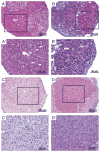Human umbilical cord blood-derived mesenchymal stem cells in the cultured rabbit intervertebral disc: a novel cell source for disc repair
- PMID: 23598901
- PMCID: PMC4238943
- DOI: 10.1097/PHM.0b013e31825f148a
Human umbilical cord blood-derived mesenchymal stem cells in the cultured rabbit intervertebral disc: a novel cell source for disc repair
Abstract
Objective: Back pain associated with symptomatic disc degeneration is a common clinical condition. Intervertebral disc (IVD) cell apoptosis and senescence increase with aging and degeneration. Repopulating the IVD with cells that could produce and maintain extracellular matrix would be an alternative therapy to surgery. The objective of this study was to determine the potential of human umbilical cord blood-derived mesenchymal stem cells (hUCB-MSCs) as a novel cell source for disc repair. In this study, we intended to confirm the potential for hUCB-MSCs to differentiate and display a chondrocyte-like phenotype after culturing in micromass and after injection into the rabbit IVD explant culture. We also wanted to confirm hUCB-MSC survival after transplantation into the IVD explant culture.
Design: This study consisted of micromass cultures and in vitro rabbit IVD explant cultures to assess hUCB-MSC survival and differentiation to display chondrocyte-like phenotype. First, hUCB-MSCs were cultured in micromass and stained with Alcian blue dye. Second, to confirm cell survival, hUCB-MSCs were labeled with an infrared dye and a fluorescent dye before injection into whole rabbit IVD explants (host). IVD explants were then cultured for 4 wks. Cell survival was confirmed by two independent techniques: an imaging system detecting the infrared dye at the organ level and fluorescence microscopy detecting fluorescent dye at the cellular level. Cell viability was assessed by staining the explant with CellTracker green, a membrane-permeant tracer specific for live cells. Human type II collagen gene expression (from the graft) was assessed by polymerase chain reaction.
Results: We have shown that hUCB-MSCs cultured in micromass are stained blue with Alcian blue dye, which suggests that proteoglycan-rich extracellular matrix is produced. In the cultured rabbit IVD explants, hUCB-MSCs survived for at least 4 wks and expressed the human type II collagen gene, suggesting that the injected hUCB-MSCs are differentiating into a chondrocyte-like lineage.
Conclusions: This study demonstrates the abiity of hUBC-MSCs to survive and assume a chondrocyte-like phenotype when injected into the rabbit IVD. These data support the potential for hUBC-MSCs as a cell source for disc repair. Further measures of the host response to the injection and studies in animal models are needed before trials in humans.
Figures





Similar articles
-
An in vitro study investigating the survival and phenotype of mesenchymal stem cells following injection into nucleus pulposus tissue.Arthritis Res Ther. 2009;11(1):R20. doi: 10.1186/ar2611. Epub 2009 Feb 11. Arthritis Res Ther. 2009. PMID: 19210770 Free PMC article.
-
The Traceability of Mesenchymal Stromal Cells After Injection Into Degenerated Discs in Patients with Low Back Pain.Stem Cells Dev. 2019 Sep 1;28(17):1203-1211. doi: 10.1089/scd.2019.0074. Epub 2019 Jul 23. Stem Cells Dev. 2019. PMID: 31237488
-
Human umbilical cord-derived mesenchymal stem cells and their chondroprogenitor derivatives reduced pain and inflammation signaling and promote regeneration in a rat intervertebral disc degeneration model.Mol Cell Biochem. 2021 Aug;476(8):3191-3205. doi: 10.1007/s11010-021-04155-9. Epub 2021 Apr 17. Mol Cell Biochem. 2021. PMID: 33864569
-
The effects of microenvironment in mesenchymal stem cell-based regeneration of intervertebral disc.Spine J. 2013 Mar;13(3):352-62. doi: 10.1016/j.spinee.2012.12.005. Epub 2013 Jan 20. Spine J. 2013. PMID: 23340343 Review.
-
Growth and differentiation factor-5 contributes to the structural and functional maintenance of the intervertebral disc.Cell Physiol Biochem. 2015;35(1):1-16. doi: 10.1159/000369670. Epub 2015 Jan 2. Cell Physiol Biochem. 2015. PMID: 25547527 Review.
Cited by
-
Discovery and Application of Postnatal Nucleus Pulposus Progenitors Essential for Intervertebral Disc Homeostasis and Degeneration.Adv Sci (Weinh). 2022 May;9(13):e2104888. doi: 10.1002/advs.202104888. Epub 2022 Feb 23. Adv Sci (Weinh). 2022. PMID: 35195356 Free PMC article.
-
[Research progress of intervertebral disc endogenous stem cells for intervertebral disc regeneration].Zhongguo Xiu Fu Chong Jian Wai Ke Za Zhi. 2017 Oct 15;31(10):1267-1272. doi: 10.7507/1002-1892.201703036. Zhongguo Xiu Fu Chong Jian Wai Ke Za Zhi. 2017. PMID: 29806333 Free PMC article. Chinese.
-
Investigating the physiological relevance of ex vivo disc organ culture nutrient microenvironments using in silico modeling and experimental validation.JOR Spine. 2021 Mar 2;4(2):e1141. doi: 10.1002/jsp2.1141. eCollection 2021 Jun. JOR Spine. 2021. PMID: 34337330 Free PMC article.
-
Biomaterial-supported MSC transplantation enhances cell-cell communication for spinal cord injury.Stem Cell Res Ther. 2021 Jan 7;12(1):36. doi: 10.1186/s13287-020-02090-y. Stem Cell Res Ther. 2021. PMID: 33413653 Free PMC article. Review.
-
Efficacy of matrilin-3-primed adipose-derived mesenchymal stem cell spheroids in a rabbit model of disc degeneration.Stem Cell Res Ther. 2020 Aug 24;11(1):363. doi: 10.1186/s13287-020-01862-w. Stem Cell Res Ther. 2020. PMID: 32831130 Free PMC article.
References
-
- United States Bone and Joint Decade. The Burden of Musculoskeletal Diseases in the United States. Rosemont, IL: The American Academy of Orthopaedic Surgeons; 2008.
-
- Anderson DG, Tannoury C. Molecular pathogenic factors in symptomatic disc degeneration. Spine J. 2005;5:260S–6S. - PubMed
-
- Gruber HE, Hanley EN., Jr Analysis of aging and degeneration of the human intervertebral disc. Comparison of surgical specimens with normal controls. Spine. 1998;23:751–7. - PubMed
-
- Zhang Y, An HS, Tannoury C, et al. Biological treatment for degenerative disc disease: Implications for the field of physical medicine and rehabilitation. Am J Phys Med Rehabil. 2008;87:694–702. - PubMed
Publication types
MeSH terms
Substances
Grants and funding
LinkOut - more resources
Full Text Sources
Other Literature Sources

